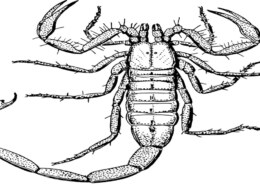Did Scorpions Evolve From Lobsters?
Scorpions and Lobsters are quite similar in shape, though different habitats and life processes.
Many have seen lobsters as water scorpions or scorpions that live in water, but the question remains that, is there any link between scorpions and lobsters? well there are but a few similarities.
And can it be said that Scorpions evolved from Lobsters? Quite not
These two creatures both have a mutual ancestor, because all living things on Earth are related.
But this common ancestor was not like any of them. It now appears that crustaceans (including lobsters and crabs) and arachnids (including scorpions and spiders) separated very early.
Probably the common ancestor was some soft-bodied worm-like creature. In fact, spiders and scorpions are more closely related to velvet worms than to lobsters.
Are Scorpions Associated With Lobsters

Scorpions and lobsters belong to the same group. They belong to the class of arthropods (Phylum Arthropoda).
Scorpion appendages have some similarities with other arthropods such as lobsters and crabs. They also have similarities with spiders and other arachnids.
The most superficial similarity between lobsters and scorpions is, of course, their claws (or “pincers”), which in both cases are very useful for defense, predation, food separation, courtship, etc. The common ancestor of both probably possessed some of these features.
Interestingly, while a lobster’s claws serve as two front legs, a scorpion’s claws are attached to its head and serve mainly to grasp and catch its prey.
This distinction contributes to the fact that scorpions are known as predators – along with their ability to secrete venom when they sting their prey as regards they do both have poison glands in their tail.
Lobsters, of course, do not have such a “poisonous” sting. Nevertheless, their claws can be quite painful.
Remarkably, both scorpions and lobsters have evolved and are fitted with an exoskeleton – they wear their skeleton on the outside!
Arthropod exoskeletons consist of chemically hardened protein and a biomaterial called chitin and cuticle.
Lobsters live in water. The ancestors of scorpions migrated out of the water several hundred million years ago.
Their close relatives, the horseshoe crabs, still live in the water. (Despite the name, horseshoe crabs are more closely related to scorpions than crabs.)
Both scorpions and lobsters walk on eight legs.
Less obvious, however, is the fact that both animals can regenerate a lost leg-though it takes a long time to do so.
Interestingly, the scorpion can also detach its tail, also known as the sting, to choose a way to escape in the face of danger.
However, the scorpion once detached from its tail, unfortunately, loses the ability to sting for the rest of its life.
Scorpions and lobsters are known to usually live alone, which can sometimes explain their aggressiveness when meeting other people.
Scorpions, when in comfort, rarely change their chosen territory – and generally prefer to call a dark burrow their home. They don’t live in groups, tend to wander through life alone and usually cover only a short distance in their lifetime.
The same is true of lobsters, which, like scorpions, live alone in a particular area, often preferring to take shelter under a rock, whether underwater or on the sandy bottom of the sea.
In general, a rock means another outer shell used for comfort and protection.
Scorpions and lobsters are considered very territorial, meaning they tend to stay put as soon as they find a cozy spot, which explains why they are not always seen out in the open.
Because lobsters are aquatic animals, they can be found in or near water, and like scorpions, they tend to stay put.
Although scorpions live on land, lobsters have been known to live out of water for only a couple of days. Likewise, a scorpion can live underwater for no more than 48 hours.
It is also interesting to note that both scorpions and lobsters are nocturnal animals, that is, creatures of the night.
Indeed, both animals prefer to roam at night, keeping daytime activity to a minimum. This further explains why they often go unnoticed.
In fact, lobsters, like most bottom-dwelling and deep-diving animals, are nocturnal creatures to one degree or another.
Scorpions, which belong to the class of arachnids such as spiders, are also considered nocturnal to some degree. The degree of nocturnal vision and activity is determined by the animal’s conditioned behavior.
This means that they can grow up to become less nocturnal – and thus become diurnal, which means the animal is active during the daytime.
Both animals are known for their aggressiveness when it comes to establishing dominance in their community or territory. Not only do they regularly engage in fights until the winner is on top, but they are also known to be aggressive toward each other when arguing over shelter, food, and mating.
Unlike lobsters, scorpions are represented as dangerous in folklore and myths almost all over the world.
Moreover, in folklore and myths, almost universally throughout the world, scorpions are known to represent uncleanness and sin.
Ultimately, through their representation in myth and folklore, or their use in symbolism in relation to culture and nature, scorpions and lobsters have rightfully taken their place on the stage of life-though they remain somewhat shrouded in mystery.
Remember that, funnily enough, lobsters are not immortal and scorpions are not evil (unless you are stung by one of them, in which case you may have a different opinion).
On the contrary, they are both part of the wonders and diversity of life.



Leave an answer
You must login or register to add a new answer.